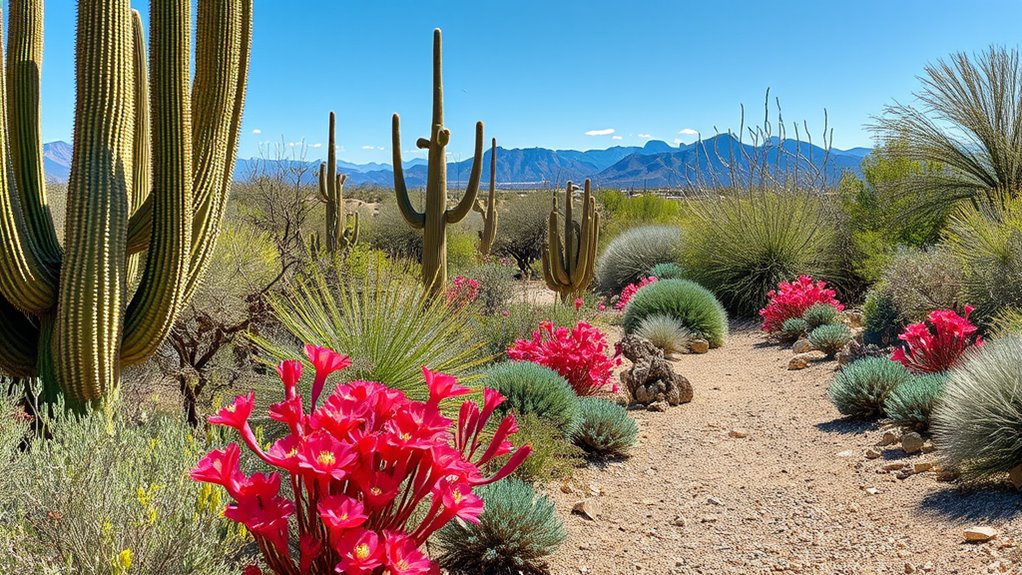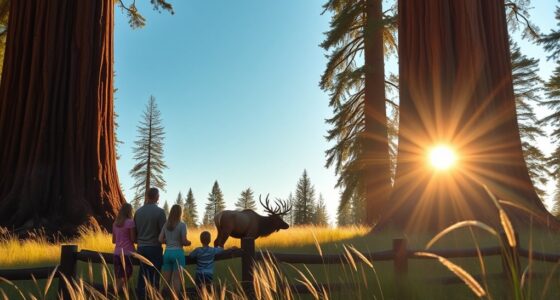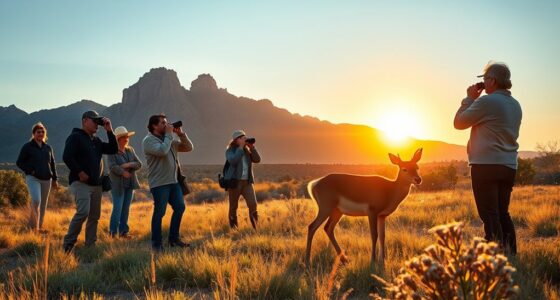To preserve native plant gardens in Arizona, choose drought-tolerant species suited to your local environment, and use sustainable practices like mulching and efficient watering. Engage with community organizations, attend workshops, and support native nurseries to learn how to maintain healthy habitats. Avoid invasive species and focus on habitat connectivity to protect biodiversity. With ongoing care and community involvement, you can help sustain Arizona’s unique ecosystems—discover more ways to make a lasting impact.
Key Takeaways
- Promote native plant conservation through community workshops, citizen science, and educational programs to raise awareness and engagement.
- Select drought-tolerant native species suited to Arizona’s environment to ensure sustainable, low-maintenance gardens.
- Partner with local nurseries and conservation organizations for expert guidance and access to native plants.
- Employ sustainable gardening practices like mulching, organic soil amendments, and efficient watering to preserve native habitats.
- Support habitat restoration projects and advocate for native landscaping to strengthen ecological resilience and biodiversity.
The Significance of Native Plants in Arizona’s Ecosystems
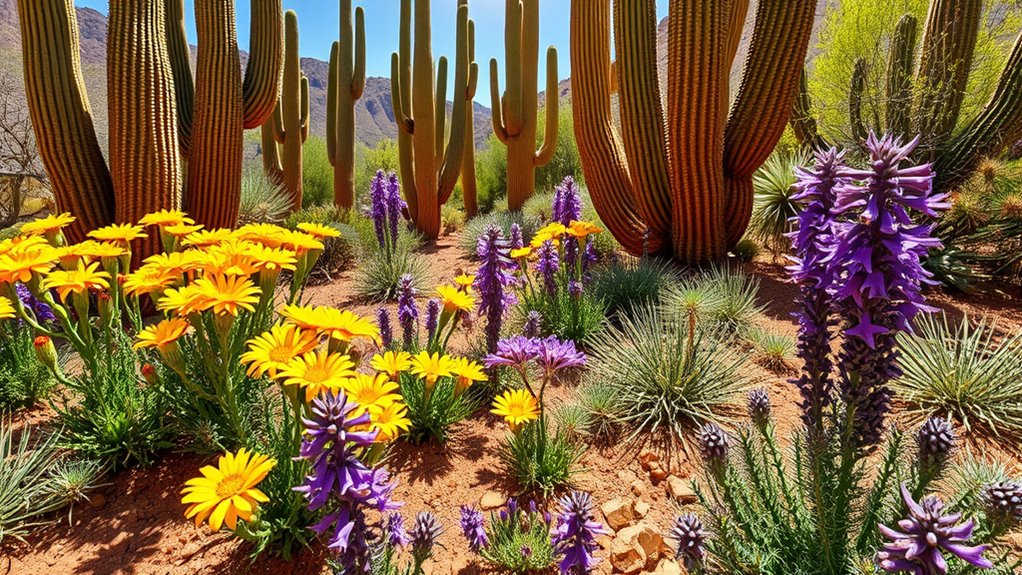
Native plants play a crucial role in Arizona’s ecosystems because they are uniquely adapted to the region’s climate and soil conditions. They provide essential pollinator habitats, supporting bees, butterflies, and hummingbirds that keep the ecosystem thriving. These plants also hold deep cultural significance for Native communities, symbolizing traditions, spiritual practices, and local heritage. By planting native species, you help preserve these important connections, ensuring pollinators have the resources they need to survive and flourish. Additionally, native plants tend to require less water and maintenance, making them a sustainable choice for your garden. Embracing native flora not only benefits the environment but also honors the rich cultural history of Arizona’s diverse communities. Your efforts contribute to a resilient, vibrant landscape.
Challenges Facing Native Gardens in the Desert Southwest
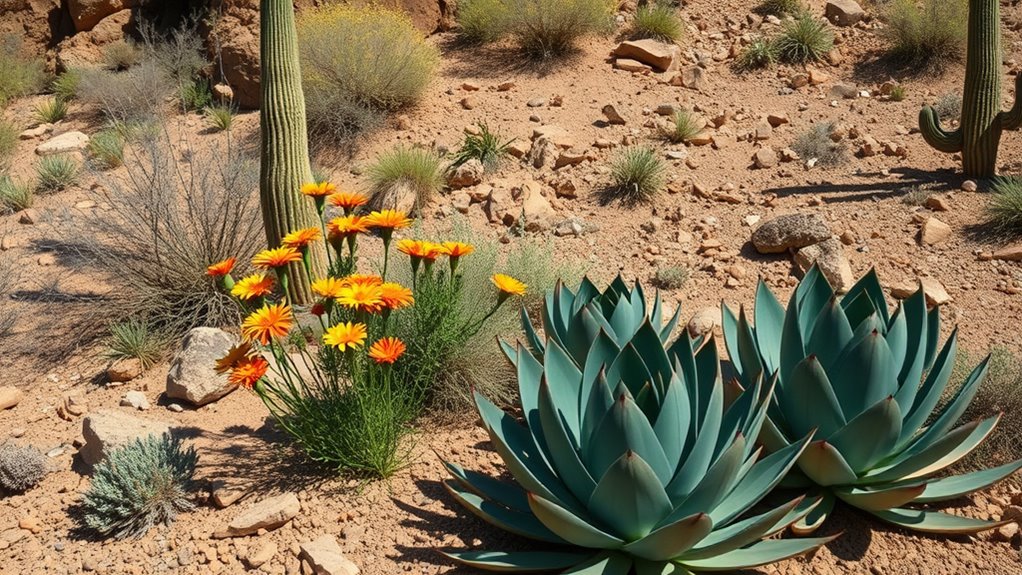
You’ll face challenges like limited water resources and increasing urban development that threaten native gardens. These issues make it harder to maintain healthy plants and preserve natural habitats. Addressing these concerns is key to keeping native gardens thriving in the desert Southwest.
Water Scarcity Concerns
Why is water scarcity such a pressing issue for gardens in the Arizona desert? Water is limited, making conservation essential for native plant gardens. You can address this challenge through strategies like rain harvesting, which captures and stores rainfall for dry periods. Xeriscaping is also key, involving drought-tolerant plants that need minimal watering. To maximize water efficiency, consider:
- Using native plants adapted to low water needs
- Installing drip irrigation systems
- Mulching to reduce evaporation
- Grouping plants with similar water requirements
- Avoiding overwatering and runoff
These methods help preserve water resources, ensuring your native garden thrives despite scarce supplies. Thoughtful planning and sustainable practices are crucial for maintaining lush native landscapes amid ongoing drought conditions.
Urban Development Impacts
Urban development poses significant challenges to native gardens in the Desert Southwest by fragmenting natural habitats and altering the landscape. As urban sprawl expands, it encroaches on native ecosystems, reducing available space for plants adapted to desert conditions. Habitat fragmentation isolates native species, making it difficult for plants to thrive and reproduce naturally. This disruption can lead to the loss of important biodiversity and diminish the ecological benefits native gardens provide. When development replaces open, native landscapes with concrete and asphalt, it not only destroys existing habitats but also creates barriers that prevent wildlife movement. To preserve native plant gardens, you need to advocate for responsible urban planning that minimizes habitat disruption and incorporates green spaces that support native vegetation. Additionally, understanding sound vibrations and their influence on ecosystems can inform more sustainable development practices that align with natural processes.
Selecting and Cultivating Indigenous Flora for Your Space
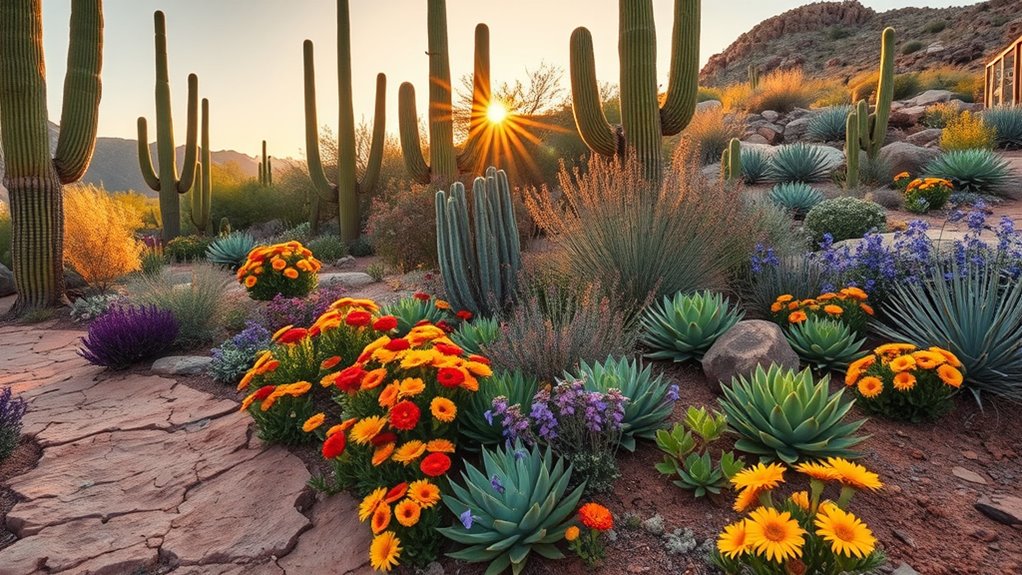
When selecting native plants, focus on species that thrive in your specific Arizona environment to guarantee success. Consider how much sunlight, water, and space each plant needs before planting. With proper cultivation tips, you’ll create a resilient garden that supports local ecosystems and requires less maintenance. Incorporating diverse plant designs can also enhance your garden’s visual appeal and ecological benefits.
Choosing Native Plants
Choosing native plants for your garden guarantees your landscape thrives with minimal effort and resources. When selecting plants, consider how they fit into your garden design, ensuring they complement existing features. Native plants are well-adapted to local conditions, making plant propagation easier and more successful. Focus on species that attract local pollinators and support the native ecosystem. Incorporating comfort and support solutions like suitable soil amendments can further enhance plant health and growth. Remember these key points: – Research plants suited for your specific soil and climate – Prioritize drought-tolerant options to conserve water – Mix different types for visual interest and biodiversity – Use native plants to create a natural, low-maintenance landscape – Choose plants that bloom at various times for continuous color This approach makes your native garden both sustainable and vibrant.
Cultivation Tips
To successfully cultivate native plants in your garden, start by selecting species that are well-suited to your local soil and climate conditions. Proper soil enrichment is key; amend your soil with compost or organic matter to improve drainage and fertility. This creates a healthy environment for roots and reduces the need for chemical pest management. When planting, choose species adapted to your area’s sunlight and moisture levels. Regular monitoring helps catch pests early, and promoting natural predators can minimize pest issues. Use the table below as a quick guide:
| Native Plant | Best Soil Conditions | Pest Management Tip |
|---|---|---|
| Desert Marigold | Well-drained, sandy | Encourage beneficial insects |
| Indian Paintbrush | Loamy, slightly acidic | Remove infested plants |
| Penstemon | Nutrient-rich, moderate moisture | Rotate plants annually |
A focus on biodiversity hotspots can guide you to select plant species that support a wide range of local wildlife.
Sustainable Practices to Maintain and Protect Native Gardens
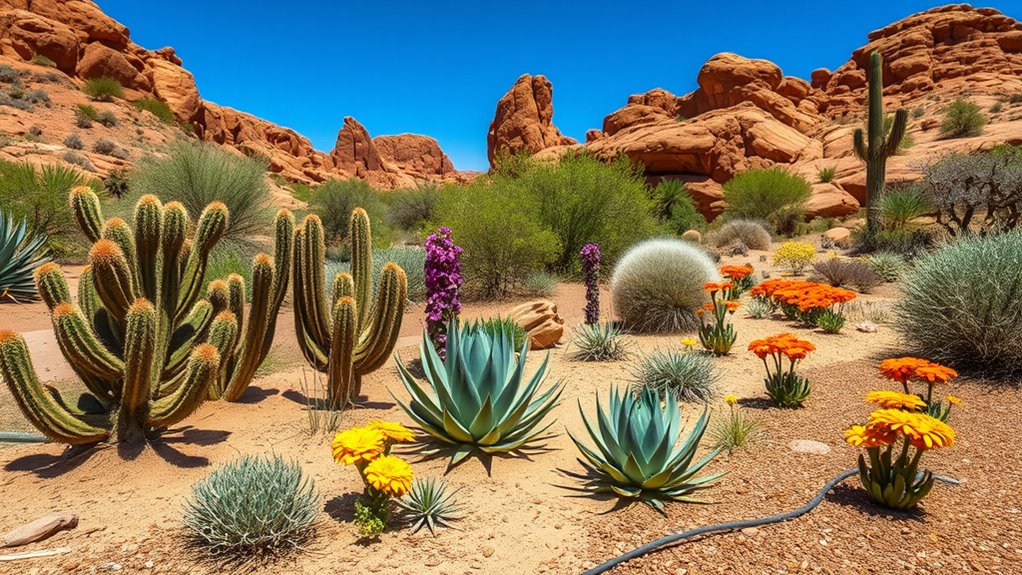
Implementing sustainable practices is crucial for maintaining and protecting native gardens in Arizona. Focus on supporting pollinators and enhancing soil health to guarantee your garden thrives. Use native plants that attract bees, butterflies, and hummingbirds, which naturally support pollinator populations. Mulching conserves moisture, suppresses weeds, and improves soil quality. Incorporate organic compost to boost soil nutrients and vitality. Minimize chemical use, avoiding pesticides that harm beneficial insects. Practice efficient watering to prevent runoff and water waste. Here are key practices:
- Plant diverse native species for pollinator support
- Use organic amendments to enrich soil health
- Mulch regularly to retain moisture
- Limit chemical inputs
- Water during early mornings or late evenings
These steps help sustain a resilient, vibrant native garden that benefits local ecosystems. Additionally, selecting appropriate irrigation techniques can improve water efficiency and further protect your garden’s health.
Engaging the Community to Promote Native Plant Conservation

Engaging the community is essential for the long-term success of native plant conservation in Arizona. You can organize community workshops to educate residents about native plants, their benefits, and how to incorporate them into local landscapes. These workshops foster awareness and inspire action, making conservation a shared goal. Additionally, encouraging citizen science projects allows community members to actively participate in monitoring plant health, tracking native species, and identifying invasive threats. When residents become involved, they develop a sense of ownership and responsibility for preserving native plant habitats. Your efforts strengthen local connections, promote sustainable landscaping, and build a network of passionate advocates dedicated to protecting Arizona’s unique ecosystems. Community engagement transforms conservation from a task into a collective movement that benefits everyone. Incorporating native plant knowledge into educational initiatives further empowers communities to make informed choices that support local biodiversity.
Resources and Organizations Supporting Native Plant Preservation

Arizona offers a variety of resources and organizations dedicated to native plant preservation that can help you get involved and stay informed. Conservation organizations like the Arizona Native Plant Society provide educational programs, workshops, and volunteer opportunities. Native plant nurseries are excellent sources for locally adapted plants, ensuring your garden thrives naturally. These nurseries often partner with conservation groups to promote native species. To maximize your efforts, consider:
- Visiting native plant nurseries for expert advice
- Joining local conservation organizations
- Attending native plant conservation events
- Accessing online resources and guides
- Participating in native plant restoration projects
Engaging with native plant nurseries can also provide valuable insights into the best practices for cultivating native species in your garden.
Frequently Asked Questions
How Can I Identify Native Plants Suitable for My Specific Arizona Location?
To identify native plants suitable for your Arizona location, start by researching your specific area’s climate and soil conditions. Conduct soil testing to understand its pH and nutrient levels, which helps in selecting compatible plants. Visit local nurseries and check plant labels for native species, ensuring they thrive in your region. You can also consult local conservation groups or botanical gardens for tailored advice on native plants that will flourish in your yard.
What Are Common Pests That Threaten Native Plants in Arizona Gardens?
Like villains lurking unseen, invasive insects and fungal diseases threaten your native plants. You should watch for pests like aphids, scale insects, and whiteflies, which suck sap and weaken plants. Fungal issues such as powdery mildew and root rot also pose risks. Regular inspections, proper watering, and natural pest control methods help protect your garden. Stay vigilant, and your native plants will thrive, resilient against these silent threats.
How Do Native Plants Adapt to Climate Change in Arizona?
You might wonder how native plants adapt to Arizona’s changing climate. They demonstrate resilience by employing climate adaptation strategies like deep root systems to access water, drought tolerance, and seasonal growth adjustments. These resilience traits help them survive extreme heat, droughts, and unpredictable rainfall. By understanding these strategies, you can better support native plants, ensuring their survival amidst climate change while maintaining the health of your garden ecosystem.
Can Native Plants Be Integrated With Non-Native Species in a Garden?
You can definitely integrate native plants with non-native species in your garden design, but it’s important to consider plant compatibility. Choose native plants that thrive in similar conditions to non-natives to ensure they coexist peacefully. This approach creates a diverse, resilient garden that supports local ecosystems while still offering variety. Just be mindful of invasive tendencies and avoid plants that might outcompete or harm native species.
What Funding Opportunities Exist for Native Plant Garden Projects in Arizona?
You can find grant programs and partnership opportunities to support native plant garden projects in Arizona. Local government agencies, nonprofit organizations, and environmental groups often offer funding to promote native landscaping. Look into programs like the Arizona Department of Environmental Quality or the Native Plant Society. By applying for these grants and forming partnerships, you can secure resources to establish or enhance native plant gardens, helping preserve Arizona’s unique ecosystems.
Conclusion
By choosing native plants, you play a crucial role in preserving Arizona’s unique ecosystems. Some believe that restoring native gardens can actually reverse environmental damage, acting as natural resilience hubs. When you cultivate indigenous flora, you’re not just beautifying your space—you’re supporting local wildlife and combating desertification. So, consider this: could your yard be the key to Arizona’s ecological future? Embrace native plants and become part of a powerful conservation movement.

